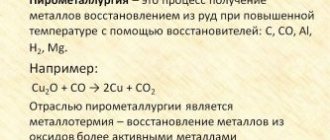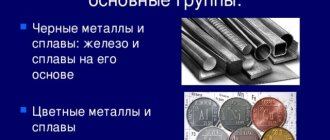Ferrous metallurgy is one of the most developed and important sectors of industrial production, the successful development of which determines the industrial potential and capabilities of any state. In many ways, it is complex, since it includes various sub-sectors, consisting in the implementation of technological processes for the extraction, enrichment of feedstock, as well as the smelting of relevant products (metals) and the production of rolled metal. The main raw material is iron ore, from which cast iron and steel are made. In this way, this industry differs from non-ferrous metallurgy, the raw materials of which are non-ferrous metals (aluminum, titanium, copper, lead, nickel, and so on).
The products of ferrous metallurgy enterprises are used, for the most part, in mechanical engineering and construction. In this regard, this industry is system-forming, and the state of industrial production as a whole largely depends on the degree of its development.
Traditionally, the state of ferrous metallurgy is assessed using such an indicator as total steel production. At the end of 2022, its global production amounted to more than 1.8 billion tons. It should be noted that this indicator has been quite stable in the recent period, which indicates sufficient development of the industry.
China is the world leader in steel production. This Asian country accounts for about half of the world's total smelting volume - about 928 million tons. India follows with a noticeable lead from China. About 106 million tons of steel were produced here. In third place is Japan, which is slightly inferior to India (produced about 104 million tons).
In addition, the following states are among the leaders in the development of ferrous metallurgy:
- USA (86 million tons);
- Russia (71 million tons);
- Germany (42 million tons);
- Brazil (34 million tons).
The above countries account for more than 2/3 of the world's industrial steel production.
Raw materials used in iron and steel industry
The main resource used to obtain products is iron ore. In Russia, its reserves are quite large and almost completely satisfy domestic needs. Separately, several ore mining areas should be highlighted.
Thus, the development of this mineral on an industrial scale began in the Urals. Large metallurgical plants, which were among the first in the country, still operate here. Also, large reserves of iron ore are located in Siberia (we are talking about the deposits of Kuzbass).
In the European part of Russia there is the so-called Kursk magnetic anomaly. According to some data, this is the largest iron ore deposit on the planet. However, development began only in the 30s of the last century and was interrupted due to the war. The deposit is located on the territory of the Kursk and Belgorod regions.
In addition to iron ore, the metallurgical industry requires coking coal. It is used as a high-quality fuel for smelting iron and loosening iron ore.
The main deposits of coking coal in Russia are concentrated in the Kuznetsk and Pechora basins.
Fireproof materials
Refractory materials are used to make the inner layer (lining) of metallurgical furnaces. They have to:
- withstand loads at high temperatures;
- resist sudden temperature changes, chemical effects of slag and furnace gases.
The fire resistance of a material is determined by its softening temperature.
According to their chemical properties, refractory materials are divided into:
- sour;
- basic;
- neutral.
Production Features
Metallurgical production involves a cycle of technological processes that can be carried out either entirely at one enterprise or at different ones. Stages:
- iron smelting;
- steel production;
- rolling production.
Thus, at full-cycle enterprises, all of the above stages are carried out. If the plant produces only rolled products, then such production is called marginal.
At the moment, the world gives preference to the development of small-scale metallurgy, where the production of steel and rolled products takes place at machine-building plants, and this significantly reduces the costs of the final product. However, large full-cycle plants remain in operation.
Typology
All metals as simple substances can also be divided into three classes:
- Black.
- Colored.
- Precious.
Non-ferrous metals include everything except precious metals and iron. That is, it is copper, mercury, palladium, chromium, nickel, zinc, magnesium, calcium, aluminum, lead, tin and so on.
Precious metals include the following:
- silver;
- gold;
- platinum
General overview of the state of ferrous metallurgy in Russia
The Russian Federation is one of the world's largest producers of cast iron, steel and rolled metal products. This is largely due to the fact that the country has rich deposits of iron ore and coking coal, used as a fuel resource. The metallurgical industry in Russia is a system-forming and highly efficient industry.
History of the development of the metallurgical industry
Humanity learned to process iron ore at the dawn of its history. Archaeologists even distinguish such a historical era as the “Iron Age,” which refers to a time period when the main tools of production were iron products.
In Russia, until the time of Peter I, metallurgy was artisanal and local in nature. And only after appropriate reforms did the industrial processing of metals begin in the country. Iron smelting began in the Urals, where the famous industrialists the Demidovs founded a number of ironworks.
After the revolution, especially during Stalin's industrialization, iron ore deposits began to be developed in Ukraine and in the area of the Kursk magnetic anomaly. During the Great Patriotic War, the main industrial capacities were deployed in the Urals and Siberia.
The 90s of the 20th century had an extremely negative impact on the development of ferrous metallurgy, but recently there has been a systematic increase in the production of steel and rolled products, which, however, has not yet reached pre-crisis levels.
Industry problems
Ferrous metallurgy is one of the most sustainable industries in our country. Its main problem is the general decline in industrial production, which was especially pronounced in the 90s of the last century. Here the issue of product sales arises, which leads to a decrease in smelting volumes.
In addition, the development of the industry is largely influenced by prices for iron ore, steel and rolled products on international markets, which are characterized by significant volatility.
Industry development prospects
The main promising directions for the development of ferrous metallurgy are:
- development of blast-furnace smelting technologies;
- increasing the share of marginal metallurgy through the use of recycled materials;
- widespread use of alloy products.
Treatment
At the processing plant, the mined ores containing ferrous metals are carefully processed. All these processes are reflected in the table below.
| Technological process | The essence of the process | Result |
| 1. Ore beneficiation | The separation of a portion of the ore containing metal from the waste rock. Can happen in one of three ways:
| A clean substrate rich in ferrous metal is obtained, which is sent for further processing. |
| 2. Agglomeration | Ore sintering process. It is carried out with the aim of obtaining a pure substance, without impurities of gases and dust, and so on. | Three types of processed ore are obtained:
|
| 3. Domain process | Coking of ore in a blast furnace using coal as a fuel and reducing iron from its oxides. | Pure iron is obtained, if necessary already fused with carbon to form steel. |
This is how iron and its alloys are obtained. In this case, the maximum material costs are spent on the preparation and use of coke (coal). It is iron that is a reducing agent, a fuel, a source of heat, and a supplier of carbon. Therefore, in the described process, a fairly large amount of it is used, hence the high financial costs.
Storage conditions
Ferrous metals primarily include iron and its alloys. It should be understood that this is a very corrosion-resistant material. Therefore, storing ferrous metal requires compliance with certain rules, especially if we are not talking about structures and products, but about the so-called scrap ferrous metals (waste, broken products, sheets, rods, fittings, and so on):
- The room in which the material is located must be completely closed from moisture (rain, snow). The less moisture, the longer the shelf life.
- The warehouse area must be large; sheet structures of ferrous metals cannot be stored close to each other, as this will provoke early corrosion.
- All available material should be sorted by brand and size.
If these simple rules are followed, it will be possible to restrain the processes of destruction of the structure of metals for as long as possible.
Test on the topic
- /10
Question 1 of 10What products are not produced by ferrous metallurgy?
Start test
Hall of Fame
To get here, take the test.
- Elena Ermakova
10/10
- Lyudmila Akanaeva
10/10
- Elena Tyaglivaya
7/10
- Zhenya Shalabanov
7/10
- Natalia Kirik
9/10
Steel
The main place among all alloys of ferrous metals is given to steel. Today we have learned to achieve very significant results in the production of this material with predetermined important properties. This kind of alloy is the most important thing for industry that ferrous metals have provided. What steels are selected?
- Low carbon - used for the production of various tools.
- Stainless steel (pipes, refractory parts, cutting tools, welding equipment, etc. are made from them).
- Ferrite-chrome.
- Martensitic-chromium.
- Alloyed.
- Nickel.
- Chrome.
- Chrome vanadium.
- Tungsten.
- Molybdenum.
- Manganese.
It is obvious from the names that these are the components that are added to the mixture of iron and carbon in a certain ratio. This affects a significant change in the properties of the resulting materials.
Secondary metals
Unfortunately, no matter how much we would like, things cannot last forever. Over time, everything becomes unusable - it breaks, breaks, grows old and goes out of fashion. This happens with structures made of ferrous metals. Steel, cast iron and other products and spare parts simply cease to be needed.
Then they are handed over to special enterprises that process raw materials that have become unusable. Now these are secondary ferrous metals. This is what metal products made of ferrous metals that are out of order and unnecessary in everyday life are called.
Those enterprises that collect scrap must comply with certain rules for its storage, removal and sale. The legislation of our country establishes GOST on this issue. Ferrous metals, as well as non-ferrous ones, are strictly controlled by law.
Recycled metals can be recycled and put back into production. It is for sale for such purposes that intermediary entrepreneurs buy ferrous scrap metals.
Today, ferrous metals are treated with due respect; they occupy leading positions in the market for relevant products.
Application area
Non-ferrous metal is used to create parts for cars, ships and aircraft. They are used to make metal structures, jewelry, and art objects. Alloys of non-ferrous metals are used in industry and medicine. With their help, equipment, hypodermic needles, and instruments for performing operations are created. Iridium is taken during radiation therapy, and gold and platinum are used in dentistry.
Ferrous metals are actively used in the food industry, in the creation of electrical engineering and energy generation. In the construction of houses, industrial buildings and cars, they are used more often than non-ferrous metal. Some alloys are specially created for harsh operating conditions, adding impurities that will make the material more stable, more reliable, etc.
Areas of application of ferrous metals
The availability and properties of the material have become the main reason for its demand in the market. Today, ferrous metal is widely used in the following industries:
- automotive industry;
- food industry;
- electrical engineering and thermal power engineering;
- industrial and civil construction;
- production of various types of products and others.
At the same time, a number of alloys with unique properties can be used in strict operating conditions. This applies to production under sudden temperature changes, in aggressive environments, and so on.










